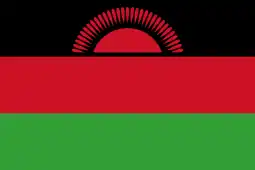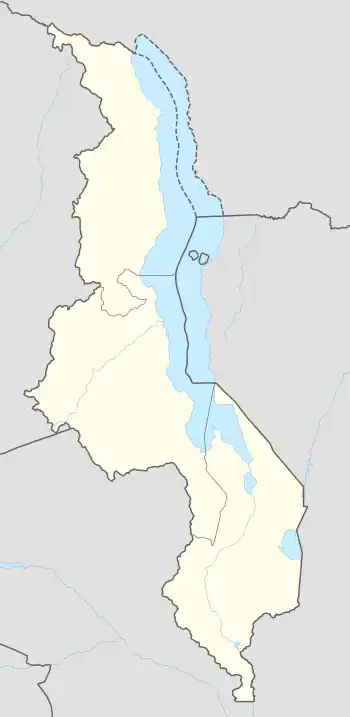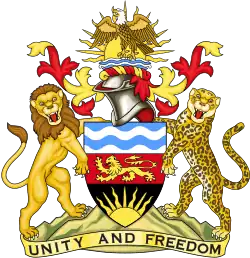


The United Nations Educational, Scientific and Cultural Organization (UNESCO) World Heritage Sites are places of importance to cultural or natural heritage as described in the UNESCO World Heritage Convention, established in 1972.[1] Malawi accepted the convention, making its historical sites eligible for inclusion on the list. As of 2023, there are two World Heritage Sites in Malawi.[2]
Location of sites
Location of World Heritage Sites in  Malawi
Malawi
List of sites
| Name | Image | Location | Criteria | Year | Description |
|---|---|---|---|---|---|
| Lake Malawi National Park |  |
Central Region, Southern Region | Natural (vii) (ix) (x) | 1984 | Located at the southern end of the great expanse of Lake Malawi, with its deep, clear waters and mountain backdrop, the national park is home to many hundreds of fish species, nearly all endemic. Its importance for the study of evolution is comparable to that of the finches of the Galapagos Islands.[3] |
| Chongoni Rock-Art Area |  |
Central Region | Cultural (iii) (vi) | 2006 | Situated within a cluster of forested granite hills and covering an area of 126.4 km2, high up the plateau of central Malawi, the 127 sites of this area feature the richest concentration of rock art in Central Africa. They reflect the comparatively scarce tradition of farmer rock art, as well as paintings by BaTwa hunter-gatherers who inhabited the area from the late Stone Age. The Chewa agriculturalists, whose ancestors lived there from the late Iron Age, practised rock painting until well into the 20th century. The symbols in the rock art, which are strongly associated with women, still have cultural relevance amongst the Chewa, and the sites are actively associated with ceremonies and rituals.[4] |
Tentative List
| Site | Image | Location | Criteria | Area ha (acre) | Year of submission | Description |
|---|---|---|---|---|---|---|
| Mulanje Mountain Biosphere Reserve |  |
Southern Region , 15°55′00″S 35°34′10″E / 15.9167°S 35.5694°E | Natural (x) | 2000 | [5] | |
| Nyika National Park |  |
Northern Region 10°40′00″S 33°50′00″E / 10.666667°S 33.833333°E | Mixed | 2000 | [6] | |
| Khulubvi And Associated Mbona Sacred Rain Shrines | Southern Region 16°45′00″S 35°10′00″E / 16.75°S 35.166667°E | Cultural (iii) (v) | 2011 | [7] | ||
| Malawi Slave Routes and Dr. David Livingstone Trail |  |
Central Region 12°55′00″S 34°18′00″E / 12.916667°S 34.3°E | Cultural (iii) (iv) | 2011 | [8] | |
| Lake Chilwa Wetland |  |
Southern Region 15°18′S 35°42′E / 15.3°S 35.7°E | Natural (ix) (x) | 2011 | [9] | |
| Vwaza Marsh Wildlife Reserve |  |
Northern Region 11°02′33″S 33°46′31″E / 11.0425°S 33.7753°E | Mixed (iii) (v) (viii) (ix) (x) | 2011 | [10] |
References
- ↑ "The World Heritage Convention". UNESCO. Retrieved November 20, 2023.
- ↑ "Malawi". UNESCO. Retrieved November 20, 2023.
- ↑ "Lake Malawi National Park". UNESCO World Heritage Centre. Retrieved 2023-11-20.
 Text was copied from this source, which is available under a Creative Commons Attribution 3.0 IGO (CC BY 3.0 IGO) license.
Text was copied from this source, which is available under a Creative Commons Attribution 3.0 IGO (CC BY 3.0 IGO) license. - ↑ "Chongoni Rock-Art Area". UNESCO World Heritage Centre. Retrieved 2023-11-20.
 Text was copied from this source, which is available under a Creative Commons Attribution 3.0 IGO (CC BY 3.0 IGO) license.
Text was copied from this source, which is available under a Creative Commons Attribution 3.0 IGO (CC BY 3.0 IGO) license. - ↑ "Mulanje Mountain Biosphere Reserve". UNESCO World Heritage Centre. Retrieved 2023-11-20.
- ↑ "Nyika National Park". UNESCO World Heritage Centre. Retrieved 2023-11-20.
- ↑ "Khulubvi And Associated Mbona Sacred Rain Shrines". UNESCO World Heritage Centre. Retrieved 2023-11-20.
- ↑ "Malawi Slave Routes and Dr. David Livingstone Trail". UNESCO World Heritage Centre. Retrieved 2023-11-20.
- ↑ "Lake Chilwa Wetland". UNESCO World Heritage Centre. Retrieved 2023-11-20.
- ↑ "Vwaza Marsh Wildlife Reserve". UNESCO World Heritage Centre. Retrieved 2023-11-20.
This article is issued from Wikipedia. The text is licensed under Creative Commons - Attribution - Sharealike. Additional terms may apply for the media files.


